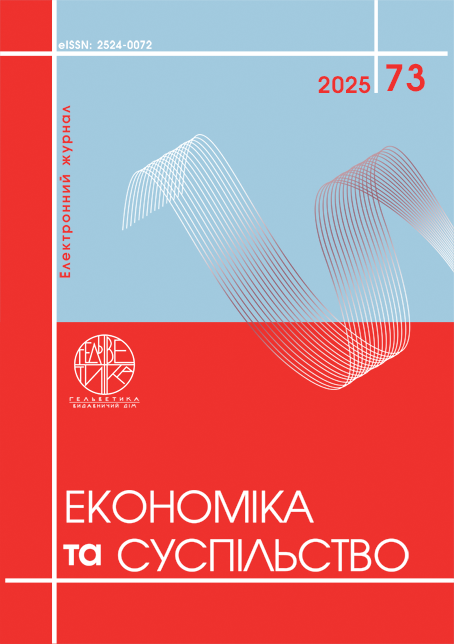FASHION INDUSTRY IN THE CONTEXT OF THE GLOBAL CREATIVE ECONOMY
Abstract
The article proves that in the modern world economic system, the dynamic development of the creative economy has become a key factor in the competitive development of states and regions. It is emphasized that the fashion industry, as one of the leading creative industries, integrates innovative approaches, digital technologies and environmental solutions, actively shaping the global market for fashion products. It not only contributes to the creation of added value, but also stimulates social cohesion, increasing the level of employment and material well-being. It is emphasized that in recent decades the fashion industry has been undergoing transformation under the influence of globalization processes, in particular the internationalization of production, environmentalization, customization of products and the dynamization of competition. It has become one of the strategic elements of the global market, actively applying the principles of sustainable development, digitalization and individualization of production. The role of new materials, biotechnology and the integration of artificial intelligence in the processes of creating fashion products is growing. The theoretical approach to the analysis of the fashion industry is also undergoing changes. Modern scientific research emphasizes the need for an interdisciplinary approach that combines economic, cultural, sociological and technological aspects. The convergence of various disciplines contributes to the expansion of the understanding of fashion as a social phenomenon and economic resource. The need for a systematic analysis of the impact of global changes on the development of the fashion industry, its adaptation to new economic challenges and the formation of sustainable development strategies in the context of the global creative economy has been established. It has been proven that the processes of production and consumption of creative goods and services produced by the fashion industry directly depend on the degree of their diversification and variety of forms. The very functioning of the fashion industry in the global conditions of the development of a post-industrial society acquires a clearly expressed organizational, economic and institutional format of a multifunctional and high-tech process, oriented towards the mass production of specific goods and services by a large number of companies and organizations.
References
Spencer H. Essays: Scientific, Political, and Speculative. Vol. 3. Library Edition, containing Seven Essays not before republished, and various other Additions. London: Williams and Norgate, 1891. Online library of Liberty. URL: https://oll-resources.s3.us-east-2.amazonaws.com/oll3/store/titles/337/Spencer_0620-03_EBk_v6.0.pdf (дата звернення 26.03.2024 р.).
Simmel G. Fashion. American Journal of Sociology. 1957. Vol. 62. No. 6. P. 541-558. URL: https://ia903100.us.archive.org/19/items/GeorgSimmelFashion/Georg%20 Simmel%20-%20Fashion.pdf (дата звернення 26.03.2024 р.).
Blumer H. Fashion: from Class Differentiation to Collective Selection. The Sociological Quarterly. 1969. Vol. 10. №3. Р. 275-291.
Tarde G. The lows of imitation. New York: Henry Holt and Company. 1903. URL: https://ia800208.us.archive.org/4/items/lawsofimitation00tard/lawsofimitation00tard.pdf (дата звернення 27.03.2024 р.).
Jensen R. The Dream Society: How the Coming Shift from Information to Imagination Will Transform Your Business. New York: McGraw Hill Professional, 1999. 292 p.
Shaw D., Jackson T. Mastering Fashion Marketing. – London: Palgrave Macmillan, 2009. 224 p.
Baudrillard J. The System of Objects. London: Verso, 1996. 224 p.
Katsumi H. Semiotic Marketing and Product Conceptualisation. In: Jean Umiker-Sebeok (Ed.). Marketing and Semiotics: New Directions in the Study of Signs for Sale. Berlin: Mouton de Gruyter, 1987. P. 421–436.
Veblen T. The Theory of the Leisure Class: An Economic Study of Institutions. – New York; London: Macmillan Co., 1899. 400 p.
Global Fashion Industry Statistics. General Data. Fashion United. URL: https://fashionunited.com/global-fashion-industry-statistics (дата звернення 28.03.2024 р.).
Total consumer spending on clothing and footwear worldwide from 2014 to 2029(in million U.S. dollars). Statista. The Statistic Portal. URL: https://www.statista.com/forecasts/1161735/fashion-consumer-spending-forecast-in-the-world (дата звернення 28.03.2024 р.).
America’s poorest families spent 60% of their income on clothing, food and housing last year. Mail Online, 17 September 2013. URL: https://www.dailymail.co.uk/news/article-2423730/U-S-spending-poorest-families-spent-60-income-clothing-food-housing-year.html (дата звернення 28.03.2024 р.).
Spencer, H. (1891). Essays: Scientific, Political, and Speculative (Vol. 3). Williams and Norgate. Online Library of Liberty. https://oll-resources.s3.us-east-2.amazonaws.com/oll3/store/titles/337/Spencer_0620-03_EBk_v6.0.pdf (Accessed March 26, 2024).
Simmel, G. (1957). Fashion. American Journal of Sociology, 62(6), 541-558. https://ia903100.us.archive.org/19/items/GeorgSimmelFashion/Georg%20Simmel%20-%20Fashion.pdf (Accessed March 26, 2024).
Blumer, H. (1969). Fashion: From Class Differentiation to Collective Selection. The Sociological Quarterly, 10(3), 275-291.
Tarde, G. (1903). The Laws of Imitation. Henry Holt and Company. https://ia800208.us.archive.org/4/items/lawsofimitation00tard/lawsofimitation00tard.pdf (Accessed March 27, 2024).
Jensen, R. (1999). The dream society: How the coming shift from information to imagination will transform your business. McGraw Hill Professional. 292.
Shaw, D., & Jackson, T. (2009). Mastering fashion marketing. Palgrave Macmillan. 224.
Baudrillard, J. (1996). The system of objects . Verso. 224.
Katsumi, H. (1987). Semiotic marketing and product conceptualisation. In J. Umiker-Sebeok (Ed.), Marketing and semiotics: New directions in the study of signs for sale (pp. 421–436). Mouton de Gruyter.
Veblen, T. (1899). The theory of the leisure class: An economic study of institutions. Macmillan Co.Fashion United. (n.d.).
Global Fashion Industry Statistics: General Data. Retrieved from https://fashionunited.com/global-fashion-industry-statistics. (Accessed March 28, 2024).
Statista. (n.d.). Total consumer spending on clothing and footwear worldwide from 2014 to 2029 (in million U.S. dollars). The Statistic Portal. Retrieved March 28, 2024, from https://www.statista.com/forecasts/1161735/fashion-consumer-spending-forecast-in-the-world.
Buchdahl E. (2013). America’s poorest families spent 60% of their income on clothing, food and housing last year. Retrieved from https://www.dailymail.co.uk/news/article-2423730/U-S-spending-poorest-families-spent-60-income-clothing-food-housing-year.html. (Accessed March 28, 2024).

This work is licensed under a Creative Commons Attribution 4.0 International License.


